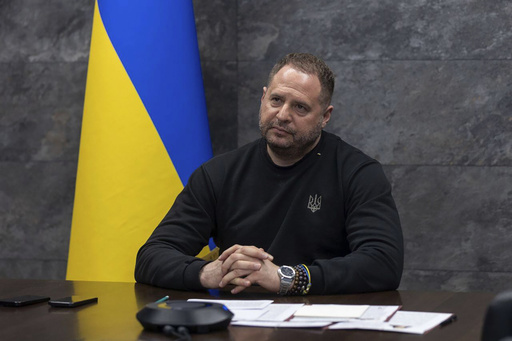
KYIV, Ukraine — President Volodymyr Zelenskyy is set to lead Ukraine’s team at the upcoming Munich Security Conference next week. Alongside Zelenskyy, U.S. Vice President J.D. Vance and special envoy for Ukraine and Russia, Keith Kellogg, are anticipated to attend, as noted by the head of the Ukrainian president’s office on Thursday.
Andriy Yermak, Zelenskyy’s chief of staff, indicated that the Ukrainian delegation’s objective is to present their stance on ending the ongoing conflict and outline perspectives for achieving “a long and lasting peace.” He emphasized that it is crucial for political leaders and experts attending the summit to recognize the current momentum, stressing the urgency of unity to prevent Russia from fracturing alliances. “We are very near to genuinely ending this war through a just and lasting peace, but collective action is essential,” Yermak stated.
The Munich Security Conference serves as a notable platform for global discussions on international security, gaining renewed significance in light of Russia’s war against Ukraine and various global challenges. This year’s conference occurs at a critical juncture for Ukraine, as it seeks to cultivate relations with the newly installed U.S. administration, which has been a pivotal ally throughout the nearly three-year conflict with Russia.
During the presidential campaign, Donald Trump asserted that he could conclude the conflict within 24 hours, later amending that timeframe to six months after taking office. Nonetheless, prospects for a ceasefire remain uncertain, with significant gaps between Russia and Ukraine’s positions. Yermak expressed hopes that discussions at the Munich conference will explore potential security guarantees designed to fend off future Russian aggression.
While no specific date has been confirmed for a meeting between Zelenskyy and Trump, Yermak reiterated the importance of arranging it promptly, stating, “We are actively pursuing it.” He also mentioned that Trump’s special envoy would visit Kyiv following the Munich Security Conference, likely at the end of February.
To ensure the new U.S. administration is adequately informed, Ukraine aims to provide Kellogg with comprehensive and accurate insights into the current battlefield situation, ongoing mobilization, and the status of weaponry and equipment supplies. Yermak underscored the importance of thorough discussions and negotiations ahead of any plans from the Trump administration, asserting that it would be a significant oversight to craft strategies without Ukraine’s involvement.
On a related note, Trump conveyed interest in reaching an agreement with Ukraine that would grant the U.S. access to the nation’s rare earth materials as a precondition for sustaining American support in its conflict with Russia. This proposal aligns with elements of Zelenskyy’s “victory plan,” which was shared with Ukraine’s allies, including Trump, last autumn. Additionally, Trump indicated that he had received communication from the Ukrainian authorities reflecting their willingness to make such a deal regarding vital resources for the high-tech economy.
Yermak acknowledged that while a specific dialogue framework on this issue has yet to be established, Ukraine is keen on cultivating a strategic partnership with the United States beyond the war and noted this aligns with Zelenskyy’s approach toward the new administration. “We want Americans to see us not only as a front for democracy during this devastating conflict with Russia but as a significant and appealing strategic partner for the future,” he articulated.
In military developments, Ukrainian forces targeted a southern Russian airfield allegedly used for deploying Iran-designed Shahed drones, the General Staff reported on Thursday. Conversely, France announced that it had sent the first batch of Mirage fighter jets to Ukraine, and the Netherlands contributed additional F-16s.
The nighttime strike on the Primorsko-Akhtarsk airfield in Russia’s Krasnodar region reportedly ignited a fire. The site serves as a base for launching drones and conducting attacks on Ukraine’s Kherson and Zaporizhzhia border regions. However, independent verification of these claims is challenging. The Russian Defense Ministry claimed to have intercepted Ukrainian drones in Krasnodar without specifying details regarding the airfield.
As part of its military strategy to enhance domestic arms production, Ukraine has been developing its own long-range drones. These drones have managed to reach targets deep within Russia, striking oil refineries, munitions depots, and airfields.
According to Sebastien Lecornu, France’s Minister of Armed Forces, the initial fighter jets promised to Ukraine by President Emmanuel Macron in June have arrived, though the exact number has not been disclosed. Ukraine’s Defense Ministry also confirmed the arrival of additional F-16s from the Netherlands, albeit without divulging specific figures.
Previously, European nations had supplied F-16 jets to Ukraine, but officials seldom referenced them in their public remarks regarding the conflict. In recent actions, Russian forces launched 77 Shahed drones and Iskander-M ballistic missiles at Ukraine overnight, according to the Ukrainian air force. Reports indicated that 56 drones were destroyed, while others were jammed and lost during flight, resulting in some property damage, although no injuries were reported.

